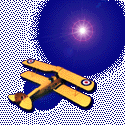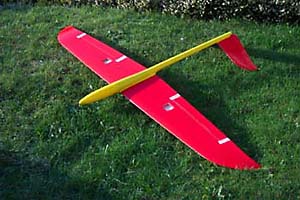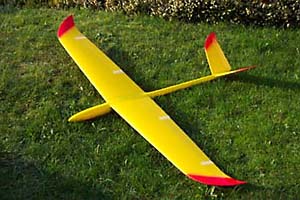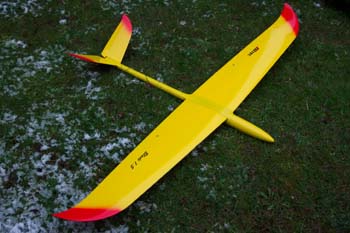

| X Models Mini Blade |
Introduction.
After nearly 4 years of service, my trusty MicroFloh suffered an almost
terminal accident in August 2005. Although repairable, I decided to sell
it on for £25, on the spot! It was sometime before I could afford
a replacement for it, so when funds allowed, I started searching.
Initially, I wanted another MicroFloh…but my attention soon focused on the X-Models Mini Blade.
The
"Blade" series of composite gliders come in various spans, and
lay-up's (Glass or Carbon). My version is the 1.5m (60") span, 2-piece
(2 servo) winged, glass version. The two photos below, show what it looked
like, about ten minutes after it arrived!
 |
 |
So
what do you get?
All mouldings are very crisp and clean. The wings are hollow, with a glass/balsa/glass
lay-up…. which are fitted with a nice chunky carbon fibre main spar.
The tail plane halves locate into the rear of the fuselage, via steel
pins pre-fitted to the tail planes. The fuselage itself has a sheath nose,
which covers the glass fibre radio bay (keel). At the centre section around
the wing root, a good dollop of carbon fibre is used (always a weak point
on models), plus there are four strips of carbon tow, running the full
length of the tail boom.
The
fittings kit is excellent, apart from the cheap looking servo covers!
The radio installation comprises of:
2 x Hitec HS-125MG servos, in the wings.
2 x Hitec HS-65HB servos in the fuz.
1 x Jeti REX 5-Ch Rx.
A custom made 4.8v, 700mAh-AAA "Ni-Mh" battery pack, built and
supplied by Multicell.
Lets
Get building!
The
Tail plane: The first thing done, was to fit the ball joints to the tail
plane halves. This is a simple job if done correctly, but I screwed the
screws in too far, and managed to pull the captive nut out of the mould.
Other than that, there were no major faults to report. If done correctly,
the kit supplied parts fit a treat.
The Wings: Again, these never presented any major headaches. The only things that need mentioning, are that routing the servo leads can be hit and miss! There is supposed to be a channel built into the wings for the leads to pass through, into the fuselage…but I couldn't see them, and didn't know about them, until reading about it on an American glider forum. That minor gripe aside, The HS-125MG's fitted into the servo wells with plenty of room and depth. The horns and pushrods made up easily too. I was slightly disappointed with the supplied White ABS plastic servo covers. I would have thought X-Models could have made some from glass fibre.
The Fuselage: The first thing to do here was to fit the two elevator servos.
Which servos you choose is critical, as room is quite limited in the relatively
short nose. I was hoping to fit a pair of HS-85MG's, but these proved
to sit too proud, and would have fouled the nosecone and the fuselage.
In the end, pair of new HS-65HB's were sourced from Steve Webb's "Servo
Shop". Even with these small servos, the standard mount needed to
be removed, as the arms still fouled the nosecone! The servos were eventually
mounted onto the keel floor, with a good dollop of epoxy and micro balloons.
 Next
on the list was to make up the elevator pushrods. These comprise of two
CF rods, with M2 threaded steel rods inserted in the ends (the CF rods
need to be cut to length, once your servos are installed). Again, these
never presented any real problems, although the tail plane ends do need
to be bent slightly, to get them to clear the tail plane mounting tubes,
in the rear fuz.
Next
on the list was to make up the elevator pushrods. These comprise of two
CF rods, with M2 threaded steel rods inserted in the ends (the CF rods
need to be cut to length, once your servos are installed). Again, these
never presented any real problems, although the tail plane ends do need
to be bent slightly, to get them to clear the tail plane mounting tubes,
in the rear fuz.
Because the model was to be my "flagship of the fleet", I decided upon buying a really good Rx. A Schulze 8.35w was duly ordered, and worked very well indeed. When it came to installing the nose weight, I found that there was very little room in the fuz, so the Schulze was replaced with a Jeti REX 5-channel Rx instead (See below). Note how the battery is well buried, but it is in there!
With everything setup and running, all that was now needed was some good weather.
Flying
The maiden flight didn't take place until New Years Eve 2005. The conditions
were good, with a good SW wind and reasonable lift. This model is about
1lb heavier than my previous MicroFloh, so I was concerned about her not
wanting to go in lighter conditions. After doing the ritual range check,
and test of the controls…she was thrown off.
 My
initial response was that she was slower than I thought she'd be. Even
though I'd set the C/G to the supplied leaflet, it was still too far back
for my liking. After adding more nose weight, she started to perform and
penetrate better. I'd just about got her singing when the conditions died
off, so we called it a day…for the year!
My
initial response was that she was slower than I thought she'd be. Even
though I'd set the C/G to the supplied leaflet, it was still too far back
for my liking. After adding more nose weight, she started to perform and
penetrate better. I'd just about got her singing when the conditions died
off, so we called it a day…for the year!
My next chance to fly her didn't materialise until the 5th March this year (2006). A 20mph NW was blowing well on Burrough Hill, with very good and constant lift all day. The Mini Blade was readied for action…and wow!
She got away with ease, and was soon started sniffing out the thermals. She is very smooth in flight, and aerobatics are easy and crisp. I'm not too confident with inverted flight, as all the moulded stuff I've owned before have struggled. Not so with the Mini Blade…as she handles very well inverted, with a minimal amount of down elevator needed.
She is fast in dives, but will also cruise around the sky quite happily. Handling qualities near the stall are excellent, and at some stages of my last flight with her, she was more like a big thermal model…very stable indeed! The ensuing dive from a great height (a trademark of mine) was brisk, with her still accelerating at the bottom...magic! The only thing that concerned me here, was that the wings did slightly flex at the joiner, as I pulled out of the dive sharply. So to anyone interested in buying this model, would be better off getting the single piece wing instead. Another thing worth noting is that the tail plane halves have a tendency to "pull out" slightly in flight, leaving a gap between the fuz and tail. Even though I put some tape across the bottom of the tail and fuz, they still moved. My advice would be to either bend the wires slightly, or to use a little dab of CA glue, to hold them in place.
Summing
Up
This model is a really good all-round slope model. She's a pleasure to
fly, agile, fast, stable…and looks good too! There's no doubt that
this model will be going everywhere I decide to fly, its nice when something
is fun and relaxing at the same time.
My rating: 99%.
Control
set-up (my preference)
Ailerons: 18mm up / 10mm down (differential).
Elevator: 3mm both ways.
Rudder: 6mm both ways.
Flaperons: 5mm down.
C/G position: 64mm back from the leading edge.
The
Mini Blade is available in the UK, through
Southcoast Sailplanes
4-6 St. Johns Road
Bournemouth
Dorset
BH5 1EL
Tel: 01202 302430 or 01202 393814
|
Specifications
|
|
| Span | 1500mm |
| Controls | R/E/A |
| Weight | 700 g |
| Profile | RG14 |
| Lay up | Glass, carbon spar in wing |
| Price | £175 |
Please
mention 'Flying Sites' when contacting
Southcoast
Sailplanes
| Info Panel |
| Comments: This model is a really good all-round slope model. She's a pleasure to fly, agile, fast, stable…and looks good too! |